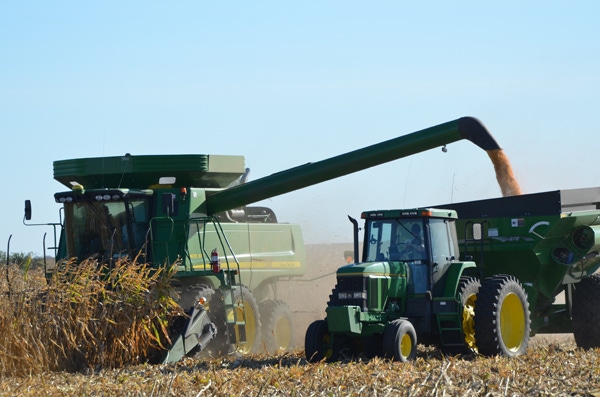
Should you choose highest corn yield or consistent corn yield?
Think Different“We need to replace the yield monitor with the profit monitor. Water management and soil biology management are intertwined in ways we have never imagined. If we started surveying fields more closely, we’d see a lot more variation than we want to admit.“If we can effectively manage the landscape to capture and hold water and manage the soil biology and bring those together, what would the potential of a piece of land be? Let's think about ways to blow the top off our production system."Jerry Hatfield, head, the National Laboratory for Agriculture and the Environment, USDA-ARS member of the Intergovernmental Panel on Climate Change special committee
November 27, 2013

High corn yields, or more consistent corn yields? High yields or more profitable yields? Two good questions for these changing times, experts say.
How do you manage for top yields in highly variable soils, when weather uncertainties, high land costs and falling crop prices have reduced the margin of error? It may require changing goals, suggests Charles Walthall, deputy administrator, Natural Resources and Sustainable Agriculture Systems Research, USDA-ARS.
"Perhaps the absolute maximum yield may not be the goal," he says. "Maybe we need to change our assumptions about how we approach farming. What are our goals, and how sustainable are they? Do they include grain quality as well as quantity? Are they economically viable? Do they enhance the environment and quality of life for rural America and society as a whole?
"Growers today have to decide whether to aim for yield with a high degree of confidence or a yield that with the right conditions will vastly outperform other hybrids," says Pat Steiner, head, corn portfolio, Syngenta North America. "Those two are not going to be the same hybrid. A grower needs the best recommendation for his risk profile."
Assumptions are already changing, he adds; the demand for resilient hybrids versus top-yielding hybrids is growing,” he adds.
Reed Mayberry, senior marketing manager-corn, DuPont Pioneer, reports grower interest in more resilient hybrids has risen as grain prices have fallen. "Growers aren't chasing high yield, but rather yield stability," he says. "That means looking not at what hybrid won yield trials two years out of three, but which one provided the most consistent results."
Like what you're reading? Subscribe to CSD Extra and get the latest news right to your inbox!
We should view everything through the interaction of genetics, environment and management practices, Walthall suggests. He acknowledges that this big-picture, multi-focus view runs counter to how science has evolved.
"Where we used to break a big problem into smaller ones and rely on bits and pieces of a solution, we now need to synthesize all the bits and pieces, putting them together and building decision trees - such as if this soil, what variety and what management practices," says Walthall.
New decision aids
The introduction of programs like Monsanto FieldScripts coming online in 2014 and Field360 from Pioneer is market recognition of the need for a different way to assess variables, to build new decision trees. Data mined from the farming operation as well as public and private research, is aggregated, analyzed and evaluated. The end results are action plans for growers to consider, tweak and follow related to inputs, processes and outputs of their systems and subsystems. Real-time inputs constantly update management plans, refine decisions and capture data for future analysis.
The value of advanced data mining and analytics in agriculture is likely to take a quantum leap forward as even more variables are defined and added to the planning process. Walthall points to the 2012 cropping year where many areas saw yields above expectation. "Even traditional varieties held up pretty well, in some cases due to the way fields were managed and what had been done to maintain soil water-holding capacity," he says.
Water management and soil biology management are intertwined in ways we have never imagined, says Jerry Hatfield, National Laboratory for Agriculture and the Environment, USDA-ARS. The laboratory director and supervisory plant physiologist also serves on the Intergovernmental Panel on Climate Change special committee to evaluate the impact of extreme events on ecosystems.
"If we started surveying fields more closely, we would see a lot more variation than we want to admit," he says. "I believe there are microsite variations within fields created by management decisions that influence how the genetics interact with the environment, and they are magnified by weather extremes."
Hatfield points to the role of organic matter in nutrient cycling and water-holding capacity, noting the tremendous variability in 2012 yields and the correlation between good yields and soil water-holding capacity. Organic matter comes from crop residue broken down through biological activity. Increased biological activity converts more carbon material and, if maintained throughout the growing season, constantly cycles nutrients for crop use.
If we want to improve soils and reduce their variability, we’d begin with how we manage soil biology as part of that complex, Hatfield says. "If we can look at field variation from this perspective, we have some tremendous opportunities to improve management for producers."
While the goal has always been to make all yields uniformly high, realistically it should be to optimize efficiencies within existing field variability, Hatfield adds.
"We need to build the soil up, recognize its variability and adjust inputs accordingly, perhaps even changing the form of the inputs," says Hatfield. "We need to replace the yield monitor with the profit monitor and look at profitability and how we manage for optimum profitability."
About the Author(s)
You May Also Like



